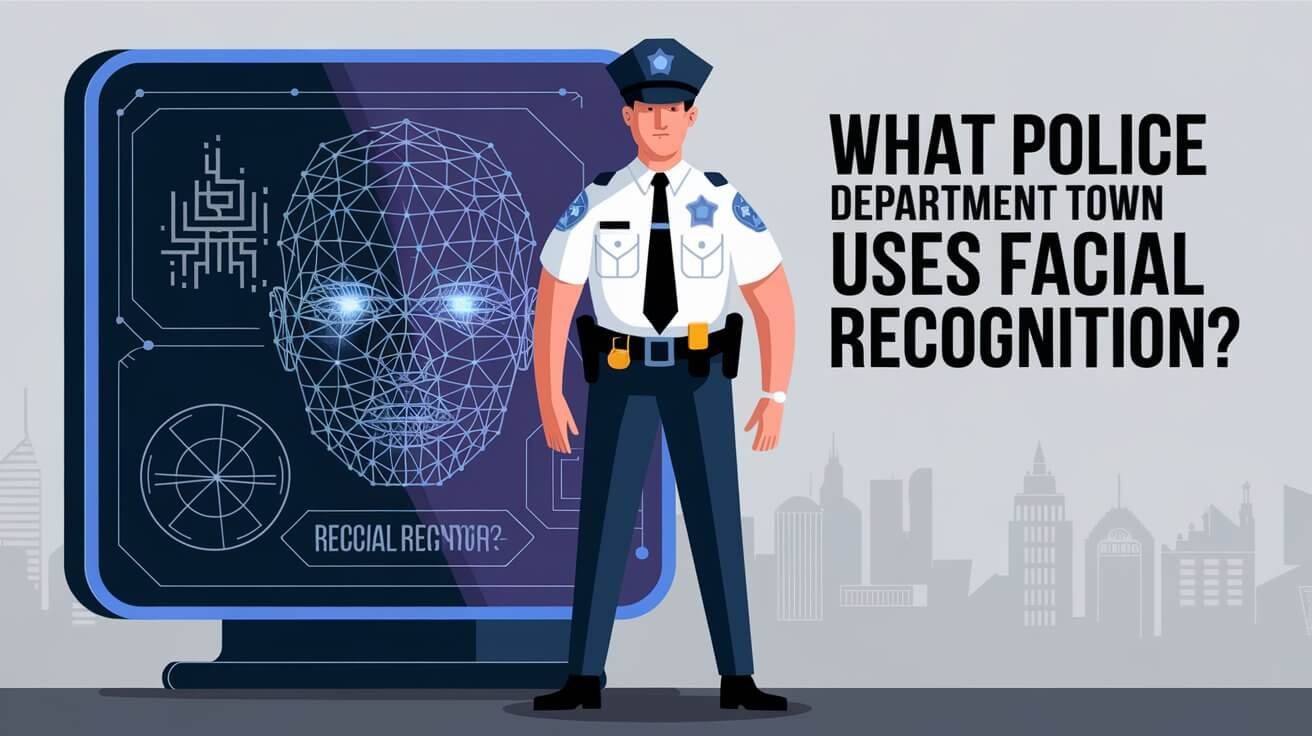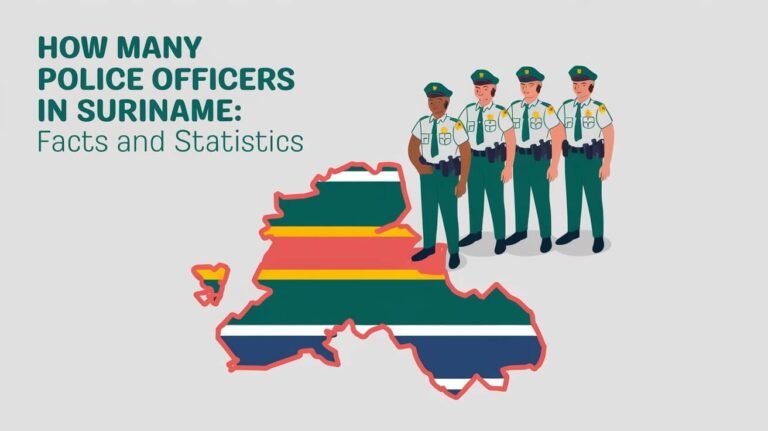What Police Department Town Use Facial Recognition?

Facial recognition technology is a hot topic in police departments today. Many cities, like Mead, are thinking about using it to fight crime. The Mead Police Department plans to start using it on August 30, 2023.
All officers will learn how to use it. This tech helps identify unknown people and suspects. It compares faces against mugshots and driver’s license photos using Lumen software.
Many police departments in the U.S. are using facial recognition. They hope it will help solve crimes. The Avon Town Council voted to let their police use it too.
It’s important to look at both sides of facial recognition. We need to think about how it affects communities. We also must make sure it’s used fairly and accurately.
Current Status of Police Facial Recognition Systems
Facial recognition technology is now used by law enforcement in the U.S. as a tool to fight crime. The use of this technology varies by location and department size. Many police departments are thinking about using it, while others are already doing so.
Major Metropolitan Police Departments
Big city police departments, like the San Francisco Police Department, are using facial recognition. Even though San Francisco banned it in 2019, the police are asking for help from other agencies to find suspects.
Small Town Implementation Rates
Smaller towns might not have the means to use facial recognition technology. Yet, some are looking into it to fight crime. The Avon Police Department’s interest in facial recognition is a good example.
Regional Adoption Patterns
How different regions use facial recognition technology varies. Some cities and states have banned it for law enforcement. For instance, 21 cities or counties and Vermont have banned its use. Here’s a table showing how different regions are adopting facial recognition technology:
| Region | Adoption Pattern |
|---|---|
| San Francisco | Banned the use of facial recognition technology in 2019 |
| Austin | Banned the use of facial recognition technology in 2020 |
| Vermont | Banned the use of facial recognition tools by law enforcement |
Law enforcement sees facial recognition technology as a valuable tool. They use it to solve crimes and find suspects. Despite concerns, many believe it helps keep communities safe.
Technology Behind Police Facial Recognition Tools
The tech behind facial recognition tools is quite complex. It uses algorithms and machine learning to study and match faces. This tech helps police watch over public areas or track people. It’s used to compare photos of suspects from many sources, like security cameras and mugshots.
Police can also check photos from the FBI and state driver’s license databases. When a match is found, it’s seen as a lead for officers to investigate. Some important facts about facial recognition tech are: * It’s used to match suspect photos after a crime. * It can spot people who threaten violence online. * Live comparisons need a court order. * Police get training on how to use it.
Facial recognition is a strong tool for police, but it also brings up privacy concerns. As it gets used more, it’s key to use it right and watch it closely. Laws in some states control how it’s used, so it’s important to know these rules.
| State | Use of Facial Recognition Technology |
|---|---|
| Colorado | Mandated by Colorado Legislature Senate Bill 22-113 |
| Other states | At least 26 states allow law enforcement to run or request searches against driver’s license and ID photo databases |
Privacy Rights and Public Surveillance Debate
The use of facial recognition technology by police has sparked a heated debate. Many worry it could be used to monitor people without their consent. This could lead to wrongful arrests. With over 85 million cameras in 2021, privacy concerns and wrongful arrests are on the rise.
Facial recognition technology has issues with bias and inaccuracy. A study by MIT and Stanford found error rates of 20% to 34% for black faces, mainly women. This raises big concerns about wrongful arrests and civil liberties.
Constitutional Considerations
The use of facial recognition technology raises constitutional questions. The Fourth Amendment protects against unreasonable searches and seizures. Using facial recognition could be seen as a violation of this right. There are also concerns about bias and inaccuracy affecting equal protection under the law.
Civil Liberty Concerns
Civil liberty concerns are a big part of the debate. The fear of mass surveillance and personal data collection without consent is significant. Groups like the ACLU have called for a ban on law enforcement using facial recognition technology.
Public Opinion Data
Public opinion on facial recognition technology is divided. Some see it as a useful tool for law enforcement, while others worry about privacy and civil liberties. A Pew Research Center survey found 56% of adults in the US think it’s okay for law enforcement to use it. But 44% disagree.
Legal Framework for Facial Recognition Use
Law enforcement uses facial recognition technology under strict laws. In the U.S., both federal and state laws govern its use. These laws protect individual rights when agencies use facial recognition.
In New Jersey, Teaneck banned facial recognition, and the Attorney General stopped Clearview AI’s tool. These moves show the importance of following laws when using facial recognition. Agencies must think about the impact and follow all rules.
Law enforcement should keep these points in mind when using facial recognition:
- Use it only for real law enforcement needs
- Have strong measures to stop misuse and protect rights
- Be open and accountable in its use
- Follow all federal and state laws
Following these guidelines, agencies can gain trust and protect people’s rights. Facial recognition is a valuable tool for law enforcement. But, it must be used lawfully and with respect for individual rights.
Case Studies: Successful Crime Prevention Results
Facial recognition technology has been a game-changer for police departments. It helps solve crimes and prevent new ones. In the United States, it has led to a 34% drop in crime and disorder.
This technology is a valuable tool for police. It can greatly improve public safety. The main benefits include:
- Improved accuracy in identifying suspects
- Increased efficiency in solving crimes
- Enhanced public safety through the prevention of crimes
A study by David Weisburd and others found facial recognition technology reduces crime. They saw a 33.8% drop in crime/disorder in areas where it was used.
| Study | Reduction in Crime/Disorder |
|---|---|
| David Weisburd, Cody Telep, Joshua Hinkle, and John Eck | 33.8% |
| Problem-Oriented Policing (POP) | 34% |
Major Arrests Through Recognition Systems
Facial recognition technology has led to many major arrests. For instance, it helped catch a suspect in a string of robberies. The suspect was charged with the crimes.
Crime Rate Impact Statistics
The impact of facial recognition technology on crime rates is significant. The study by David Weisburd and others found a 34% drop in crime and disorder. This shows its effectiveness in preventing crimes.
Cost Analysis for Municipal Implementation
Implementing facial recognition technology for surveillance comes with big costs. Municipalities need to think about the price of equipment, training, and upkeep. These factors help decide if the tech is worth it.
Some main costs include:
- Equipment expenses: The price of buying and setting up facial recognition software and hardware, like cameras and servers.
- Training requirements: The cost of teaching police how to use the tech right.
- Maintenance considerations: The cost of keeping the tech up to date and working well.
Even though facial recognition tech is pricey, many cities see it as a good investment. They think it helps keep people safe and lowers crime. As more places use this tech, it’s key to weigh the costs and benefits carefully.
Database Management and Information Sharing
Facial recognition technology needs careful handling of database management and information sharing. The way we store and share biometric data, like facial images, is a big deal. It’s important to keep this data safe and only share it with those who should see it.
Using facial recognition technology means we must think about these issues a lot. We need to make rules for managing and sharing biometric data. This includes making sure the data is correct, up-to-date, and safe from unauthorized access. Some important things to consider are:
- Secure storage and transmission of biometric data
- Access controls to ensure only authorized personnel can view or share the data
- Regular audits to ensure the accuracy and integrity of the data
- Clear policies and procedures for managing and sharing biometric data
Focusing on safe data management and sharing, law enforcement can address privacy concerns. This way, facial recognition technology can be used responsibly and effectively.
Accuracy Rates and False Identification Issues
Law enforcement’s use of facial recognition technology has raised concerns. Wrongful arrests can happen if the tech is not precise or used wrongly. It’s key to know the error rates and how different groups are affected to avoid false identifications.
Research shows that people without training can make mistakes in face recognition half the time. African Americans face more issues with police face recognition due to accuracy problems and high arrest rates. Agencies must make sure their tech is accurate and fair to avoid wrongful arrests.
To tackle these issues, some police departments are setting up rules for using facial recognition. For example, the Mead Police Department uses a tool that gives match scores. A police member reviews each match to ensure accuracy and fairness.
| Law Enforcement Agency | Number of Facial Recognition Searches | Number of Arrests | Number of Convictions |
|---|---|---|---|
| Miami Police Department | 2,500 | 186 | 50 |
Understanding facial recognition’s accuracy and false identification issues, police can reduce wrongful arrests. They can use the technology in a fair and unbiased way.
Community Response and Public Feedback
The use of facial recognition technology by police has sparked a lot of debate. Many are worried about its misuse. A study by the National Institute for Standards and Technology found it less accurate for women and Black people than for men and white people.
Some cities like San Francisco and Detroit have started to regulate its use. In Detroit, it’s only used for violent crimes and home invasions. New York City is even trying out ear recognition with facial tech.
But many people are not convinced. Only 36% of adults think private companies use facial recognition responsibly. The ACLU also worries about police altering photos, which could lead to wrong arrests.
The following table highlights some of the key statistics and findings related to facial recognition technology:
| Category | Statistic |
|---|---|
| Accuracy Rate | Lower accuracy rates for women and Black individuals |
| Public Trust | Only 36% of adults believe facial recognition is being used responsibly |
| Regulation | Some cities, such as San Francisco and Detroit, have regulated the use of facial recognition technology |
| Concerns | Potential for misuse, inaccuracy, and bias in facial recognition technology |
The community’s view on facial recognition technology is complex. Some see its benefits, while others worry about its risks. It’s important for police to listen to the community and use this technology wisely. This ensures it respects everyone’s rights and freedoms.
Safeguards and Oversight Measures
Facial recognition technology is becoming key in fighting crime and surveillance. It’s vital to have strong safeguards and oversight. This ensures it’s used right and with clear rules, tackling worries about misuse and bias.
It’s important to have good audit protocols and accountability systems. For example, regular checks can spot and fix any issues in the facial recognition system. This stops wrong identifications and makes sure the tech is fair and unbiased.
Audit Protocols
Setting up audit protocols means checking facial recognition tech often. This includes how data is gathered, kept, and used. It builds trust in the tech and its role in crime-fighting and surveillance.
Accountability Systems
Accountability systems are also key. They set up rules for using facial recognition tech. This includes ways to report and look into misuse, and penalties for wrong use.
With these safeguards and oversight, law enforcement can use facial recognition tech wisely. It respects people’s rights and keeps everyone safe. This makes it a valuable tool for fighting crime and surveillance.
Concluding Summary
The debate on facial recognition in law enforcement is ongoing. It’s important to use it responsibly. The benefits for safety and crime prevention are clear, but privacy and civil liberties are at risk.
Creating strong safeguards and oversight is key. This ensures biometric data is used right and privacy concerns are met. Regular checks, openness, and clear rules help build trust and reduce misuse risks.
As facial recognition tech grows, we must focus on everyone’s needs. This is critical for those who have been left behind. A team effort, based on data, can make facial recognition work for everyone. It keeps fairness and justice at the forefront.
Key Questions
What is the current status of facial recognition technology use in police departments across the United States?
Facial recognition technology use varies by police department size and location. Big cities often use it, but smaller towns might not have the means. Many departments are exploring its use to fight crime, with some already using it.
What are the benefits and drawbacks of using facial recognition technology in police departments?
Facial recognition can help police find suspects and watch public areas. But, it raises privacy concerns and can lead to wrongful arrests, mainly for minority groups.
What is the legal framework surrounding the use of facial recognition technology by law enforcement?
Laws about facial recognition vary by state and federal level in the U.S. Police must follow these laws when using this technology.
What are some successful case studies of using facial recognition technology for crime prevention?
Police have used facial recognition to catch suspects and prevent crimes. It’s a valuable tool for keeping communities safe and reducing crime.
What are the cost considerations for municipal implementation of facial recognition technology?
Starting up facial recognition technology costs a lot. This includes buying equipment, training, and upkeep. Police must weigh these costs against the benefits of using it.
What are the key issues surrounding the accuracy and reliability of facial recognition technology?
Facial recognition technology can be less accurate for certain groups, leading to wrong arrests. This raises fairness and bias concerns in its use by police.
How has the community and public responded to the use of facial recognition technology by police departments?
How people see facial recognition affects its use by police. It’s key for police to talk to the community and listen to their views.
What safeguards and oversight measures are in place for the use of facial recognition technology by police departments?
Using facial recognition requires careful thought about risks and consequences. It’s important to have checks and balances to ensure fair and transparent use.






